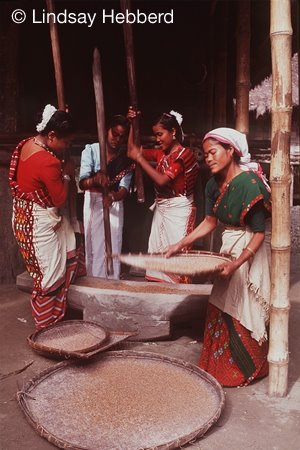--Dr Ramesh C Nayak.
Mishing tribe constitute 17.8 % of Assam’s population.
Mishing speaking population is 88% and their literacy rate is 60.1% (census
2001). Original home of the Mishings is said to be in Arunachal Pradesh from
where they have migrated to plains of Assam centuries ago. Therefore, Mishings
are found in both in Assam and Arunachal Pradesh. They are a part of Tibeto-
Burman family of Mongoloid race. Unlike other Tibeto- Burman languages,
Mishings have no scripts of their own.
But Mishings realised down the ages print literature
has been acknowledged as a part of the literary canon and has alone been
considered as proper literature. Oral literature debased and gradually erased
from the face of the earth in the course of time and along with it put an end
to a culture. In order to save the culture they must convert their dialect into
literature. This farsighted nature of Mishings gave birth to find a script to
popularise and flourish their language.
In early endeavour Assamese script was used as the
Mishing script. The pioneer in this field being Sonaram Payeng, who added two
more sound symbols and initiated the first step in popularisation and
preservance of Mishing language. His book “ Miri Doban”, 1915 is the first book
on Mishings in Assamese script. Other noteworthy writers like Dr Nomal Chandra
Pegu presented another book in 1956 titled “Mishing Abig” followed by “Mishing
Path” by Kamal Chandra Padun in 1958 and “Mishing Agom” by Bibhishan Pegu in
1963.
Earlier in 1886, J.F. Needham had written a grammar in
Roman Script under the title “Outline grammar of the Shaiyang Miri Language”
which most probably encouraged the scholars to adopt Roman script for the
development of Mishing language and literature. Finally in 1972, in the Mishing
Agom Kebang, the highest literary body of Mishings, the resolution was
unanimously passed to adopt Roman script in Dishangmukh, Shibsagar district of
Assam on 18th April. Since then Mishing language has crossed many
milestones in the field of literature in Roman Script.
Languages and dialects are dying daily, mainly due to
lack of initiative by its speaking population. Mishings in this regard are very
careful in guarding the growth of their language. Periodicals, news paper,
books, dictionaries etc have come up in many numbers and still growing. This is
a sign of Mishing effort to nourish and establish their language at par with
that of other standard languages because they understand that culture lives
through language. Death of a language means death of a culture.
Despite of a self identity established by the Mishing
language, the growth is somewhat rather slow. The reasons are many. Let’s count
a few of them.
a)
Urbanisation
/ migration : The people when go out of their own community and live in a
different language setting, new born babies are less impacted to their mother
tongue. When parental influence towards their own language becomes passive, the
child instead of learning his mother tongue starts liking the language spoken
by the majority where he lives. Assamese, Hindi being the dominant languages
and widely spoken, Mishing children, living in urban settings are not only
ignorant about their culture but also ignore their mother tongue.
b)
Parental:
In modern settings parents are less worried if their child knows Mishing. They
are worried whether their child speaks Hindi and English fluently. As a result
they also encourage their child to become more conversant in Hindi or English
than Mishing.
c)
Education:
Assamese, Hindi and English are the languages of text books in school. It is
expected that the child should master these languages. There are no text books
in Mishing and Mishing is not taught as a major subject in schools as a result
child becomes less inclined to learn the language. In the formative years a
child is forced to learn other languages on priority as a result mother tongue
is ignored.
d)
Government
policy: Government policies are not language friendly. Very little is done from
government side to support and sustain the language. Neither any periodicals in
mishing language are published by the government nor support any regular
publication to keep this language alive. I have seen many periodicals with
beautiful dreams to preserve Mishing culture but meet untimely death due to
lack of support. For Example “Promising Action”, a beautiful periodical used to
be published regularly but now a days it is not.
e)
Community/speaking
population: Survival of the language comes from its own community/people. They
need to be literate and make effort to keep it alive. Educated and elite class
should contribute for the development of the language which is not so
encouraging in case of Mishings. Well to do people should come forward for
popularisation, funding research projects and publication of books.
f)
Others:
At the same time scholars from other languages should guide, translate and help
its development. Awards may be instituted for popularising Mishing literature
For Mishings and non Mishing writers.
A healthy attitude towards this language by
other will certainly add dimensions to its growth.
The Journey starting from 1915 with MIRI
DOBAN till today almost touching a century has never been a smoother one. In
between several setbacks and hurdles, Mishing language is prospering and able
to establish itself as a language in the north east region. For this credit
must go to its people who despite of all odds have been trying to keep it
growing.
***********

No comments:
Post a Comment